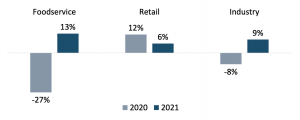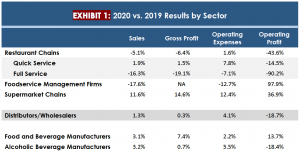
April 2, 2021
The 2020 Covid-19 pandemic caused a fundamental food industry demand shift that benefitted retail and adversely impacted foodservice. Despite an unprecedented 12% growth (+$95 billion) in retail, the significant (-27%, or -$220 billion) decline in foodservice (which was 51% of consumer food expenditures pre-pandemic) led to -8% food industry contraction, a net loss of $125 billion. With a strong rebound in foodservice looking increasingly likely during the second half of 2021 and well above-par retail growth, especially during the first half of the year, Pentallect forecasts 9% total industry growth for 2021, a gain of $135 billion¹.

To determine how various sectors performed in 2020, Pentallect assessed the results of 60 publicly traded companies, including restaurant and supermarket chains, foodservice management firms, distributors and wholesalers, and food and beverage manufacturers². The data also reveal the profit margin differentials of the various sectors we studied³.
The analysis revealed several interesting performance trends that are reflective of the demand shift we previously mentioned:
- As frequently noted, restaurant chain and foodservice management firms experienced sales and profit declines; within the restaurant sector, quick service formats far outperformed full service. Wingstop, Domino’s and Wendy’s were the only restaurant chains that were able to grow sales and operating profit.
- Despite increased operating expenses (primarily in the areas of supply chain and labor), supermarket chains demonstrated a high degree of earnings leverage as an average 11.6% increase in sales led to an 36.9% increase in operating profit. In addition to traffic gains, they derived benefits from mix and price improvements and a more effective assortment. The seven supermarket chains in the sample – Ahold, Albertsons, Grocery Outlet, Kroger, Publix, Sprouts and Walmart – all had increases in sales, gross profit and operating profit.
- Within the distributor/wholesaler sector, the foodservice-oriented companies – Performance Food Group, Sysco and US Foods – had organic sales declines and steep profit drop-offs while retail-oriented companies – Coremark, Spartan Nash and UNFI – grew their top lines and, with the exception of UNFI, their bottom lines as well.
- The performance of food and beverage manufacturers (of all types) was generally in direct correlation with their retail orientation. Those manufacturers with disproportionately large foodservice businesses (like AB Inbev, Coca-Cola, Lamb Weston, and Tyson) faced heavier “headwinds” than their more retail driven counterparts. Nevertheless, the sector was able to grow gross and operating profit and margins due to greater volume and effective operating expense management.
- As shown in Exhibit 2, quick service restaurant chains, supermarket chains and food and beverage manufacturers were able to increase their gross and operating profit margins in 2020.


The food industry is facing a confluence of high-impact factors and trends, including ongoing, unusual and geographically-varied operating restrictions, growth of non-traditional channels (especially online), consolidation, more powerful and forceful trade buyers, irregular demand patterns, supply chain bottlenecks, changing A & P and go-to-market practices, and cost increases that will significantly affect results for the foreseeable future. As foodservice recovers, we do expect many companies will have improved overall results, but the favorable effect of retail growth will moderate. Individual company performance will depend on their channel and customer portfolios and their ability to address the factors and trends noted above.
¹ The data excludes sales of alcoholic beverages
² Results reflect total company performance, including international operations. In some cases, results are for a partial year
³ Averages are unweighted
By: Bob Goldin and Rob Veidenheimer
Want to know more about how your company can take greater advantage of these and other significant trends? In light of Pentallect’s latest growth forecast, would you benefit from reviewing your plans? To speak with a Pentallect partner about opportunities for growth or meeting developing challenges:
